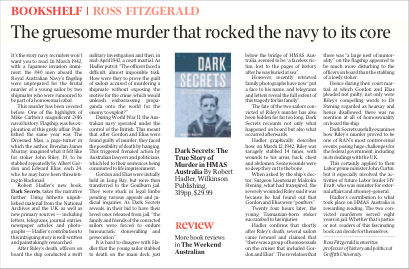 The gruesome murder that rocked the navy to its core
The gruesome murder that rocked the navy to its core
Australian – Thursday, 10 Dec 2020 – Page 10
It’s the story navy recruiters won’t want you to read. In March 1942, with a Japanese invasion imminent , the 840 men aboard the Royal Australian Navy’s flagship were unprepared for the brutal murder of a young sailor by two shipmates who were rumoured to be part of a homosexual cabal.
This murder has been covered before. One of the highlights of Mike Carlton’s magnificent 2016 naval history, Flagship, was his exploration of this grisly affair. Published the same year was The Drowned Man, a page-turner in which the author, Brendan James Murray, imagined what it felt like for stoker John Riley, 19, to be stabbed repeatedly by Albert Gordon and Edward Elias, each 24, who he may have been threatening to blackmail.
Robert Hadler’s new book, Dark Secrets, takes the narrative further. Using hitherto unpublished material from the National Archives and the UK, as well as new primary sources — including letters, telegrams, journal entries, newspaper articles and photographs — Hadler’s contribution to this intriguing story is well-written and painstakingly researched.
After Riley’s death, officers on board the ship conducted a swift military investigation and then, in mid-April 1942, a court martial. As Hadler puts it: “The officers faced a difficult, almost impossible task. How were they to prove the guilt of sailors accused of murdering a shipmate without exposing the motive for the crime, which would unleash embarrassing propaganda onto the world for the enemy to exploit?”
During World War II, the Australian navy operated under the control of the British. This meant that, after Gordon and Elias were found guilty of murder, they faced the possibility of death by hanging. This triggered frenzied action by Australian lawyers and politicians, which led to their sentences being commuted to life imprisonment.
Gordon and Elias were initially held in Long Bay, but were then transferred to the Goulburn jail. They were stuck in legal limbo pending various appeals and judicial inquiries. As Dark Secrets reveals, in their bid to have their loved ones released from jail, “the family and friends of the convicted sailors were forced to endure bureaucratic stonewalling and persecution’’ .
It is hard to disagree with Hadler that the young sailor stabbed to death on the main deck, just below the bridge of HMAS Australia , seemed to be “a faceless victim , lost to the pages of history after he was buried at sea” .
However, recently retrieved family photographs have now “put a face to his name, and telegrams and letters reveal the full extent of this tragedy for his family” .
The fate of the two sailors convicted of Riley’s murder has also been hidden for far too long. Dark Secrets recounts not only what happened on board but also what occurred afterwards.
Hadler graphically describes how, on March 12, 1942, Riley was savagely stabbed 14 times, with wounds to his arms, back, chest and abdomen. Some wounds were so deep they cut to the bone.
When asked by the ship’s doctor , Surgeon Lieutenant Malcolm Stening, what had transpired, the severely wounded Riley said it was because he had found out that Gordon and Elias were ‘‘ poufters’’ .
Twenty four hours later, the young Tasmanian-born stoker succumbed to his injuries.
Hadler confirms that shortly after Riley’s death, several sailors came forward and claimed that “there was a group of homosexuals on the cruiser that included Gordon and Elias” . The revelation that there was “a large nest of immorality” on the flagship appeared to be much more disturbing to the officers on board than the stabbing of a lowly stoker.
Hence during their court martial , at which Gordon and Elias pleaded not guilty, not only were Riley’s compelling words to Dr Stening regarded as hearsay and hence disallowed, there was no mention at all of homosexuality on board the ship.
Dark Secrets usefully examines how Riley’s murder proved to be one of RAN’s most controversial events, posing huge challenges for the federal government, including in its dealings with the UK.
This certainly applied to then Labor prime minister John Curtin, but it especially involved the activities of future Labor leader HV Evatt, who was minister for external affairs and attorney-general .
Hadler’s contribution to what took place on HMAS Australia is rewarding reading. The two convicted murderers served eight years in jail. Whether that’s justice or not, readers of this fascinating book can decide for themselves.
Ross Fitzgerald is emeritus
professor of history and politics at Griffith University.
Copyright © 2020 News Pty Limited
